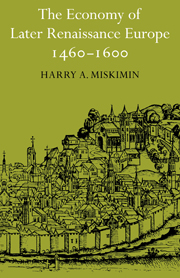Book contents
- Frontmatter
- Contents
- List of tables, graphs, maps
- Dedication
- Preface
- 1 The abstractions of law and property
- 2 Recovery: population and money supply
- 3 Agriculture: the rising demand for food
- 4 Industry: technology and organization
- 5 Trade patterns in the wider world
- 6 Finances: private and public
- 7 Retrospect
- Notes
- Bibliography
- Index
6 - Finances: private and public
Published online by Cambridge University Press: 30 September 2009
- Frontmatter
- Contents
- List of tables, graphs, maps
- Dedication
- Preface
- 1 The abstractions of law and property
- 2 Recovery: population and money supply
- 3 Agriculture: the rising demand for food
- 4 Industry: technology and organization
- 5 Trade patterns in the wider world
- 6 Finances: private and public
- 7 Retrospect
- Notes
- Bibliography
- Index
Summary
That sixteenth-century policy makers were obsessed with bullion flows is beyond doubt, yet even if many of their recommendations and policies appear irrational to us, some very real and pressing problems demanded resolution. The bullion shortage that depressed the European economy during the later middle ages seems progressively to have worsened during the first half of the fifteenth century and then to have been alleviated with the opening of the central European mines and the consequent increase in the amount of precious metal available to the mints. The impact of shortage on contemporary thought is self-evident, but implicit in this terse précis of monetary history, simple enough on the surface, lies a more complex and difficult problem that vexed early modern financial administrators and unsettled European monetary systems. In the modern world, the connection between bullion and the money supply is tenuous indeed; most countries have long since abandoned the least pretense that the domestic money supply is in any way related to the amount of bullion held in reserve or contained in the coinage. In the later middle ages, however, this was not the case; the money supply was virtually identical to the bullion supply and this identity was perpetuated despite the efforts of almost all the monarchs of the period. It is this congruence that simultaneously makes it possible to speak of a long-term monetary shortage and that rendered the problem so intractable.
- Type
- Chapter
- Information
- The Economy of Later Renaissance Europe 1460–1600 , pp. 155 - 179Publisher: Cambridge University PressPrint publication year: 1975

